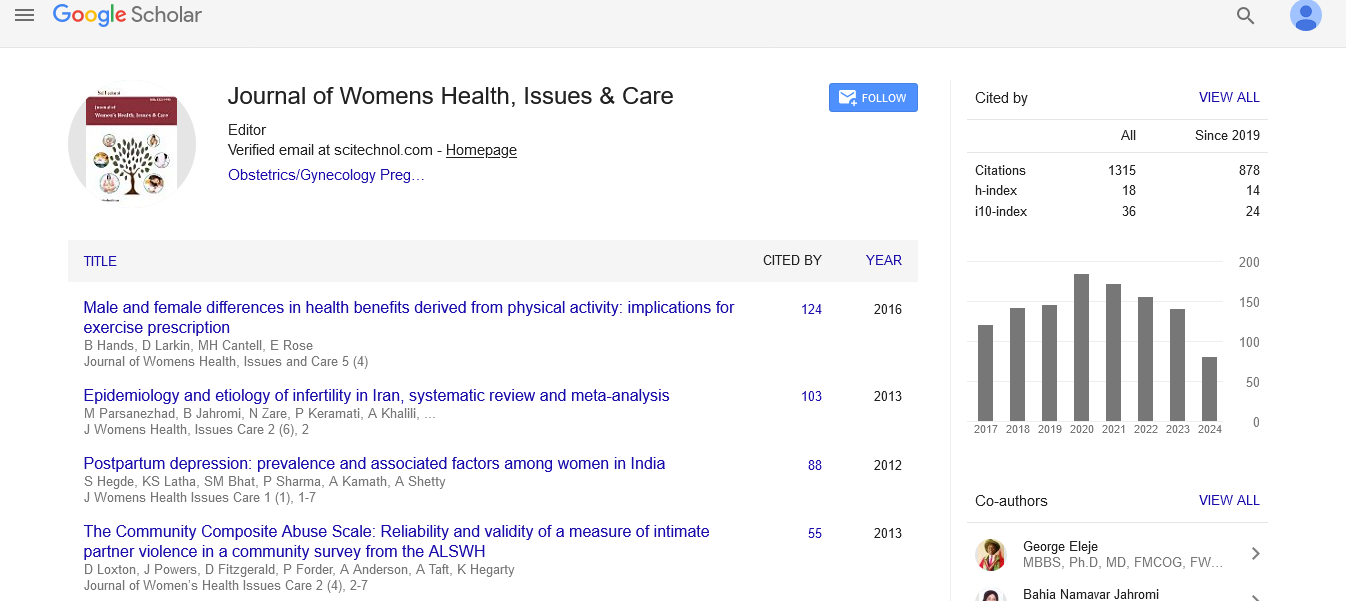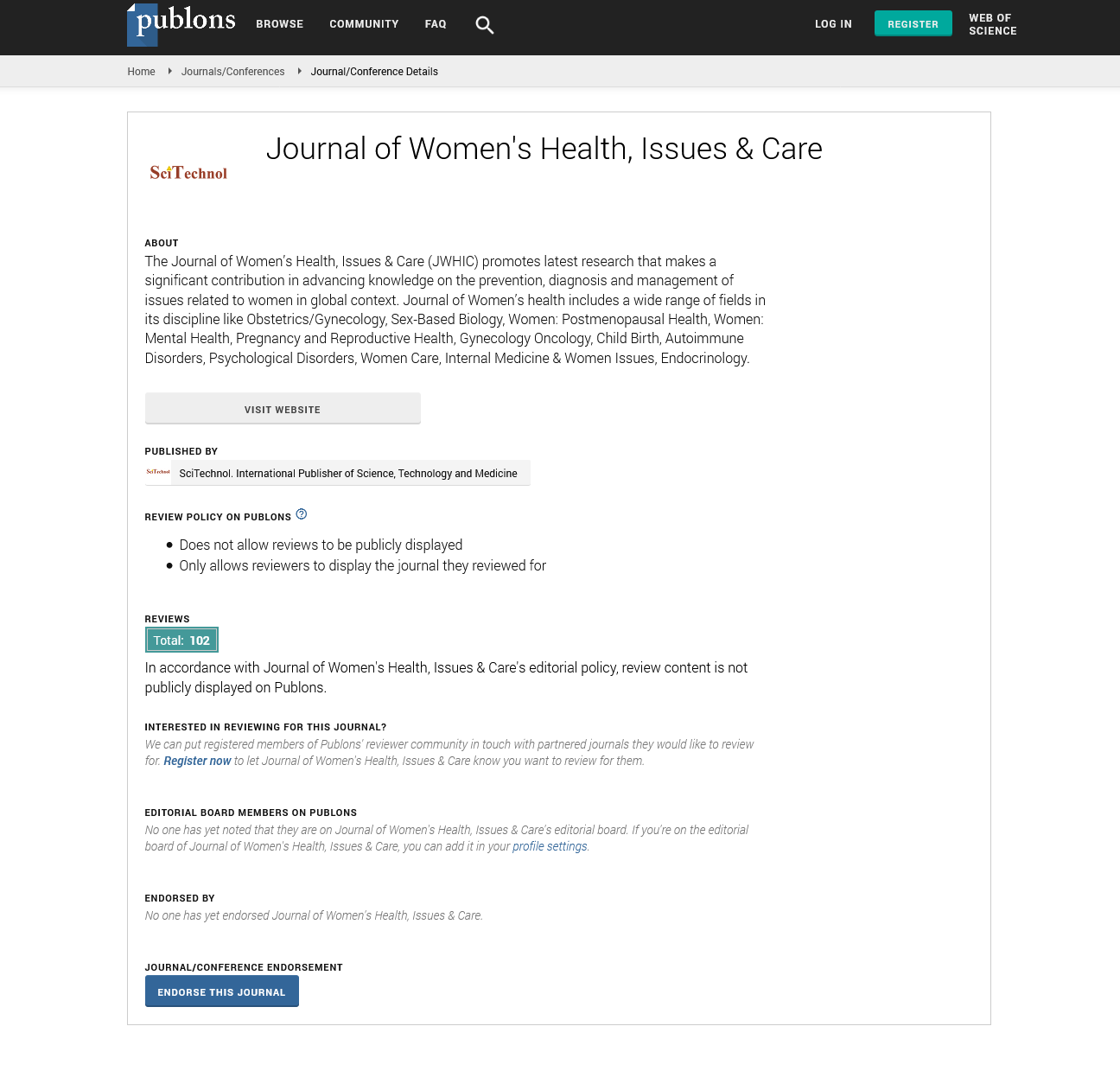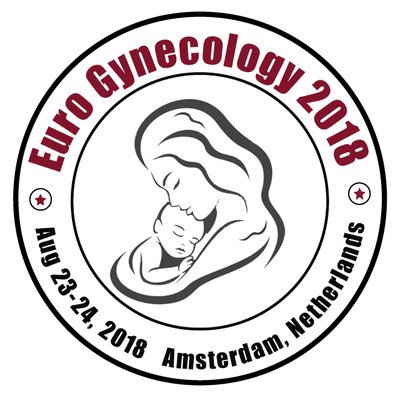Review Article, J Womens Health Vol: 14 Issue: 1
Socio-economic Assessment of Female Labors in Micro-scale Enterprises
Mahima Nand*and Arpit Verma
Department of Product Design, Sage University, Bhopal, India
*Corresponding Author: Mahima Nand
Department of Design, Sage University, Bhopal, India
E-mail: dr.mahimanand@gmail.com
Received date: 31 July, 2023, Manuscript No. JWHIC-23-108629;
Editor assigned date: 03 August, 2023, PreQC No. JWHIC-23-108629 (PQ);
Reviewed date: 17 August, 2023, QC No. JWHIC-23-108629;
Revised date: 22 January, 2025, Manuscript No. JWHIC-23-108629 (R);
Published date: 29 January, 2025, DOI: 10.4172/2325-9795.1000537
Citation: Nand M, Verma A (2025) Socio-economic Assessment of Female Labors in Micro-scale Enterprises. J Womens Health 14:1..
Abstract
India's overall economic activity, women account for around one-fifth of the labor force. Few of them work in the organised sector. Notwithstanding mandatory legislative safeguards, both the organised and unorganised sectors of the economy are abused to the same extent. This study aims to highlight the impact of education and well-being of female employees on cluster development. It adopts qualitative and quantitative approaches to execute the results that identified existing work conditions of male employees in the lower operations section in the readymade garment industry. Statistical units applied in the study are descriptive analysis, correlation, and regression to analyze the impact of the social well-being of men on the local environment as the minimum unit of data collection. The population identified for the study is adult women (18 yrs and above) working in micro scale units in readymade garment industry in Madhya Pradesh, India.
Keywords: Well-being; Quality of life; Readymade garment industry; Social-economic assessment
Introduction
India is a lower-middle-income country with a population of about 1.3 billion people. Despite tremendous progress in improving overall economic performance, the country's productivity levels remain relatively low. Regarding labor productivity, India's industrial sector outperforms China, Russia, South Africa, Malaysia, and Brazil. The 2019 World Economic Forum (WEF) global competitiveness report ranked India 68th out of 140 countries. This is primarily due to the country's inability to stay up with similarly ranking nations.
Social innovations refer to innovative activities and services that satisfy social needs. According to the definition proposed by Bund, et al. Social innovations include the following elements: From the business perspective, social sustainability helps understand the impacts of corporations on people and society. It identifies both positive and negative impacts on people as the quality of the company's relationship. It provides a basic knowledge of the core of the sustainable business as the social dimension often gets less attention even after being an essential part of the social development of any business. It's like a vast umbrella that ensures all society needs covering issues like poverty and hunger. Health and wellbeing, education, gender equality, and so on. Linking these social subcategories gives every business an equal opportunity to grow and contribute.
Engardio refers to social dimensions as people's welfare, education, and charitable causes. These practices offer a price to society. It concentrates the communication between people and organizations with an ethical fact of "being good" to the community, which directly affects the performance and property. The social bottom line characterizes the demand for applications contributing to human capital, society, and labor. In 2017 the Journal of accounting and finance reported that the business's mental object of social responsibility adversely affects the property and performance of that business. Recent studies have shown that the execution of these social responsibilities increases the company's value. The social dimension is quality of life, public prosperity, and gratification for future generations. It requires new involvements and approaches of different professionals in every planning, design, and development expertise. The readymade garment industry in Indore is increasing daily with fast-changing fashion trends. There are 2200 garment units in Indore, mainly in the form of sole proprietary and partnership.
The study contributes to the existing literature by providing the logs to be filled by industry personnel to improve the social well-being of the business and community, as it has become the need of the hour for all organizations to play a significant role in social development for the community. It has explored grey areas of lower operations where the social well-being of men plays a significant role in community development. The out result of the study will help to incorporate policies on factors like male education and social well-being that will impact employee efficiency and community development.
About indore cluster
In 2002, the Government of India created Ambedkar Hastashilp Vikas Yojana (AHVY) under the textile ministry. Under this scheme, the government has re-organized different geographic locations of India, having traditionally and culturally invested communities in the business of textiles. These communities still operate in this business domain, but due to global competition and the inability to meet the supply and demand, this tradition needs handholding from the government. However, these clusters don’t identify traditional businesses from machine-driven businesses but guarantee fair trade and other subsidies to the traditionally invested communities. A cluster is a geographic concentration (a city/town/few adjacent villages and their adjoining areas) of units producing similar products and facing collaborative opportunities and threats. An artisan cluster is geographically concentrated (mostly in villages/townships) of household units producing handicraft/handloom products. In a typical cluster, such producers often belong to a traditional community, making the long-established products for generations. Indeed, many artisan clusters are centuries-old artisan.
Literature Review
They focus on women's being in the majority in readymade garment sector. The study was qualitative by conducting interviews, and observations were carried out using a checklist instrument to investigate the health hazard of female industrial workers in the readymade garment industry [1]. In the study, the researcher found that many respondents were unconcerned about environmental or physical damage like weakness, eye strain, and headaches caused by insufficient light, ventilation system, or dirty workplace. In the study, tries to assess the socio-economic status of poor women workers in readymade garment industry with the commitment conditions of these workers [2]. For this, purposive sampling is used with a sample size of 215 women workers from 20 selected firms. Statistical tools like frequency distribution, tables, and graphs were used. The study revealed that these workers have a shallow commitment rate affecting industrial development negatively. In their study, compared the current level of compliances in occupational health and safety and revealed the uniform effects [3]. Two hundred-one factory records are used to analyze descriptively and test statistically. The results showed significant differences amongst inspected areas and highly different factory patterns, focusing on the well-being areas.
Kabir, et al. adopted a qualitative descriptive approach to 27 RMG workers using purposive sampling to assess the working conditions of employees in the RMG industry since the 1980’s. The inductive thematic analysis reviews the data and seriously identifies workers' health and well-being [4].
Nagata yields major findings that identified the division of labor involved in the production by comparing 20 female operators' wage assessments. Hence this article examines the skills, wages, and house holdings of female workers.
Kashiwagi, et al. infers the effect of glomeration on the technical efficiency of small and medium-sized garment firms in Egypt. 502 firms were estimated with efficiency components. They applied a switching regression model to address self-selection. They promoted the agglomeration of garment firms and fostered forward and backward linkages to improve their efficiency and develop global value chains.
In their paper, Alamgir, et al. explores how critical factors in the Bangladesh garment sector who constitute the local production system of the global supply chain experienced the implementation of global agreements on factory safety. Their outcome indicates that neoliberal development policies of the state where local economies are incorporated into global production networks resulted in differential treatment and regulation of specific populations that comprise garment factory workers.
Alam, et al. inferred the relevance of including the RMG sector in the Science and Technology Park of Extremadura (PCTEx), a prominent member of the Association of Science and Technology Parks of Spain (APTE), Spain in Badajoz zone. The study uses a case study method based on face-to-face interviews using an unstructured, open-ended questionnaire.
In the study inferred, unregistered foremanship and undeclared subcontracting seem to stem from the loose enforcement of these laws due to the deficiencies in the legal system in general in Turkey. Economic growth costs are enlightened, hurting the environment and human rights.
It aims to answer how and why CSR embraced challenges in the Myanmar export garment industry. Empirical and temporal settings were chosen to examine the contestation. This study combines GPN analysis and institutional theories [5].
Research gap
No scholarly research has been conducted in RMG cluster Indore, Madhya Pradesh that assessed the quality of life and wellbeing of female workers in micro scale MSME units making it a glaring gap in literature and knowledge.
Research question
Does well-being of men impact on social sustainability of RMG cluster?
Research scope
After conducting the study, it was clear that there is a massive scope in the knowledge domain. Knowing a concept is easy, but the implication of the process is way too tricky, especially when the target group is uneducated to understand the concept. Nevertheless, recommendations to improve the situation have a good scope for incorporating social factors into business [6].
Aim and objective
• To identify the social economic status of women in micro scale units of RMG cluster.
• To analyse the impact of social well-being of female employees on social sustainability of micro scale enterprises.
Methodology
Saunders, et al. commented that research strategy is the general plan that aids the researcher in addressing the research issues. Earlier, Bryman defined research strategy as the general orientation for conducting research. Saunders, et al. also mentioned that research strategy should be appropriately selected based on the research objectives and questions, resources available and the extent of knowledge to be researched, and the theoretical underpinnings of the research. Different research strategies can be selected based on the above criteria to ensure the study's success. In the current research, the researcher has opted for mixed methods [7]. The qualitative and quantitative data are gathered to understand the impact of the sustainable practices adopted by the garment manufacturing industries in Pardeshipura, Indore. So, in this case, two research strategies are selected: Survey and interview.
The current study analyzes the social well-being of male workers in readymade garment cluster in Indore as the sector contributes most of the city's revenue.
The first step of the study, the information available on the currently operational in-house stitching units in RMG cluster of Indore were collected using a questionnaire. Feedback from personnel working in the industry was taken, with a total of 50 male workers selected for the study.
The study is conducted to understand the impact of education and the well-being of men in social cluster development. The samples are collected from selected micro-scale units in readymade garment cluster, Pardeshipura, Indore, Madhya Pradesh. The context of the study is men who are employed in the lower division of operations in micro-scale units.
Factor analysis was used for data analysis to take out factors for the study. Out of 38 only 14 factors proved to have more than 58% of thecontribution in the E study and so were selected for further analysis. Regression was then applied on the selected factors to test its variance and significance.
Respondent profile
The general respondents are either not educated or less educated. All respondents are female. Even if the respondents have a degree, they cannot communicate in English. The primary language of these respondents is Malawi, Nimari, and affiliate dialects. This research identified a local help to converse in regional language for accessible communication. The age group of the respondents was wary from 25 to 50 years. Other age groups have either refused to respond or did not participate in the conversation.
A total of 50 respondents have been involved out of more than 60 respondents approached with a survey schedule carrying 50 questions in which ten questions were about the demographic inquiry and 40 were based upon Likert scales of 5 points.
Data collection method
The data has been collected using quesstionnaire survey of 50 adult women labours in micro scale enterprises of readymade garment cluster, Indore Madhya Pradesh. It was analyzed using discriptive analysis, regression. From the survey 11 factors were extracted using factor analysis which had highest value which were: Local environment, quality of life, globalization impact, local life satisfaction. Local economy, environmental concern local economy, social sustainability, global threat, self-esteem, local issue [8].
Demographic profile of respondents
They are initiating a connection in which participants are significant for any research, which is why the researcher intends to highlight the demographic profile of participants as well.
To measure the social status of the respondent's data are collected through the variables (earning member of their family, working hours, average monthly overtime, experiencing social changes, harassment in the workplace, practices of labor law in the factory, social acceptance, importance in the family decision) are presented.
Economic conditions of men RMG workers in the RMG cluster organize and presents economic conditions-related indicators (such as salary structure, bonus structure, medical facilities, maternity benefits, savings condition, transportation facilities, consumption pattern, accommodation condition etc.) are presented in the paper [9].
Discussion
Lastly, commitment conditions of women RMG workers that include the variables such as level of job satisfaction, organisational commitment, employee turnover rate, employee motivation, trust in their current employer, expectation to the owner, working environment and other indicators were examined. If a community wants peace, it must address a population's social wellbeing, as, without necessities, it will persist [10]. Access to basic needs and basic education is the primary motive of any socially welloff community. It also includes a state where migrants who were violently taken out of their homes may be sent back safely to their communities, prioritizing the stability of people. Social sustainability is difficult to achieve, yet prioritizing what is necessary for survival may resolve disputes to some extent, keeping in mind the impact of every action taken. An end state where one can coexist peacefully with opportunities in the community for an advance is socially well off. It is identified by equal access to basic needs like food, shelter or education, and community life [11]. It is essential to comprehend the manufacturing processes used to create fashion items, which makes them, and how workers are treated.
Implications for management and policy makers Owners, users, and management must focus on developing preventative measures and strategies to ensure the correct well-being. There is a lack of awareness on the side of owners regarding their responsibility for eventually ensuring that the well-being concept conforms with all applicable health and safety requirements.
Social well-being theory
Well-being challenges include acute water, food, shelter, or essential infrastructure crises. Thousands of labor in the Madhya Pradesh RMG industry are essential to the global supply chain for clothing. However, this industry's workers are susceptible to poor health and general wellness.
Given Madhya Pradesh's political and social climate, a change in this circumstance is improbable in the absence of more substantial unwanted pressure.
Conclusion
Finally, this research adds to our awareness of the hazards these situations pose to the health and general wellbeing of Indore's RMG industry employees. Researchers from Asian countries, particularly those in South and Southeast Asia, where the majority of RMG factories are situated, may use our findings as a foundation to further investigate the effects of these working conditions on the employee's daily, monthly, and annual work while producing clothing for unidentified consumers around the world.
Limitations
Only 50 female workers were included in the study, and conclusions were drawn. The results are so constrained. The results across only one cluster location were startlingly comparable, where workers were all hired from various industries.
By studying the existing working conditions in the micro-scale units of the RMG cluster, this study helped to demonstrate the true status of male health and well-being, which impact their employment. The results suggest that factory owners and brands benefit from the poorly existing working regulations of RMG cluster, limiting workers' right to have access to necessary basic resources. We would like to thank all of the leaders of the garment trade unions who participated as well as the garment workers who took part in the study.
Declarations
Authors have conceived and designed the experiments; performed the experiments; analyzed and interpreted the data; contributed reagents, materials, analysis tools or data; wrote the paper.
References
- Azad TS, Faysal GM, Moon, JM (2022) The industrial health hazard among workers of apparel sector in Bangladesh. Indones J Occup Saf Health 11: 133-142.
- Akhter S (2022) Socio-economic status of women workers to ready-made garments industry in Bangladesh: a study on selected firms. Doctoral dissertation, University of Dhaka.
- Karanikas N, Hasan SMT (2022) Occupational health and safety and other worker well-being areas: Results from labour inspections in the Bangladesh textile industry. Saf Sci 146: 105533.
- Kohli N, Mehta M (2022) Occupational stress among textile industry worker. IOSR J Human Soc Sci 27: 1-7
[Crossref]
- Krieger N, Rowley DL, Herman AA, Avery B, Phillips MT (2022) REPRINT OF: Racism, sexism, and social class: Implications for studies of health, disease, and well-being. Am J Prev Med 62: 816-863.
[Crossref] [Google Scholar] [PubMed]
- Quesado P, Marques S, Silva R, Ribeiro A (2022) The balanced scorecard as a strategic management tool in the textile sector. Adm Sci 12: 38.
- Reza N, du Plessis JJ (2022) The garment industry in Bangladesh, corporate social responsibility of multinational corporations, and the impact of COVID-19. Asian J Law Soc 9: 1-31.
- Seddighikhavidak S, Jamal T (2022) Interrelations of ancestral textile handicraft weaving and tangible vernacular karkhanehs (workspaces) in the historic destination of Yazd, Iran. Sustainability 14: 6363.
- Suarez-Visbal L, Stuckrath C, Carreon JR (2022) Assessing through a gender-inclusion lens the social impact of circular strategies in the apparel value chain: The Dutch case. In social and cultural aspects of the circular economy Routledge, 136-159
- Teachey KA (2022) Exploring corporate social responsibility in supplier relationships of the apparel industry. M.Sc Thesis, North Carolina State University, USA.
- Yasin I, Nayyar S (2022) Women workers well-being and workplace standards in textile mills of Kashmir (India): A socio-legal investigation under the Indian factories Act of 1948. Empl Responsib Rights J 35: 1-13.
 Spanish
Spanish  Chinese
Chinese  Russian
Russian  German
German  French
French  Japanese
Japanese  Portuguese
Portuguese  Hindi
Hindi 



